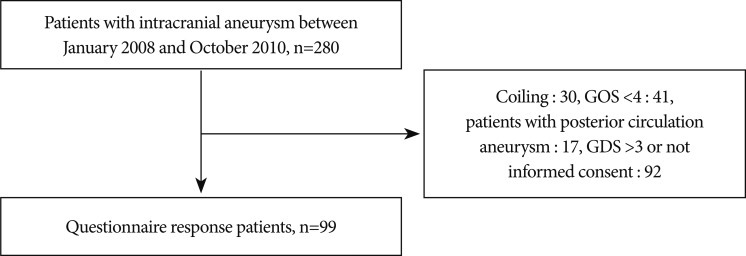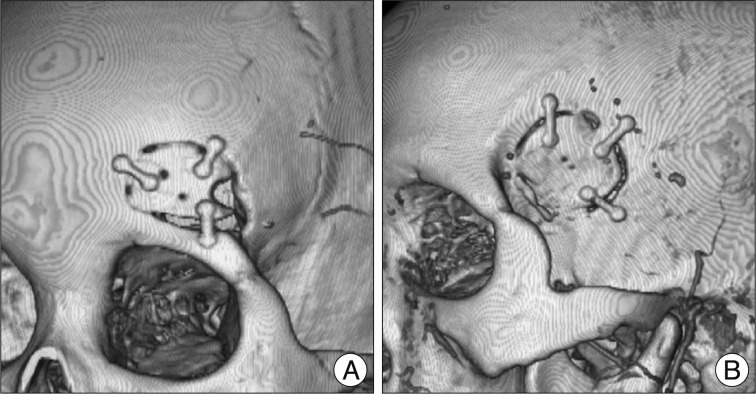J Korean Neurosurg Soc.
2012 Sep;52(3):179-186.
The Quality of Life of Patients with Good Outcomes after Anterior Circulation Aneurysm Surgery Assessed by the World Health Organization Quality of Life Instrument-Korean Version
- Affiliations
-
- 1Department of Neurosurgery, Incheon St. Mary's Hospital, The Catholic University of Korea College of Medicine, Incheon, Korea. argus3620@gmail.com
Abstract
OBJECTIVE
Even in the patients with neurologically good outcome after intracranial aneurysm surgery, their perception of health is an important outcome issue. This study aimed to investigate the quality of life (QOL) and its predictors of patients who had a good outcome following anterior circulation aneurysm surgery as using the World Health Organization Quality of Life instrument-Korean version.
METHODS
We treated 280 patients with 290 intracranial aneurysms for 2 years. This questionnaire was taken and validated by 99 patients whose Glasgow Outcome Scale score was 4 and more and Global deterioration scale 3 and less at 6 months after the operation, and 85 normal persons. Each domain and facet was compared between the two groups, and a subgroup analysis was performed on the QOL values and hospital expenses of the aneurysm patients according to the type of craniotomy, approach, bleeding of the aneurysm and brain injury.
RESULTS
Aneurysm patients showed a lower quality of life compared with control patients in level of independence, psychological, environmental, and spiritual domains. In the environmental domain, there were significant intergroup differences according to the type of craniotomy and the surgical approach used on the patients (p<0.05). The hospital charges were also significantly different according to the type of craniotomy (p<0.05).
CONCLUSION
Despite good neurological status, patients surgically treated for anterior circulation aneurysm have a low quality of life. The craniotomy size may affect the QOL of patients who underwent an anterior circulation aneurysm surgery and exhibited a good outcome.
MeSH Terms
Figure
Reference
-
1. Cedzich C, Roth A. Neurological and psychosocial outcome after subarachnoid haemorrhage, and the hunt and hess scale as a predictor of clinical outcome. Zentralbl Neurochir. 2005; 66:112–118. PMID: 16116553.
Article2. Chen L, Tian X, Zhang J, Huang Y, Chen E, Lan Q. Is eyebrow approach suitable for ruptured anterior circulation aneurysms on early stage: a prospective study at a single institute. Acta Neurochir (Wien). 2009; 151:781–784. discussion 784. PMID: 19424659.
Article3. Deruty R, Patet JD, Mottolese C, Portilla F. Long-term outcome of the management of ruptured intracranial aneurysm. Review of 328 consecutive patients treated over a period of 12 years. Neurol Res. 1988; 10:217–220. PMID: 2907108.
Article4. Hackett ML, Anderson CS. The Australian Cooperative Research on Subarachnoid Hemorrhage Study Group. Health outcomes 1 year after subarachnoid hemorrhage : an international population-based study. Neurology. 2000; 55:658–662. PMID: 10980729.
Article5. Hop JW, Rinkel GJ, Algra A, van Gijn J. Changes in functional outcome and quality of life in patients and caregivers after aneurysmal subarachnoid hemorrhage. J Neurosurg. 2001; 95:957–963. PMID: 11765839.
Article6. Hütter BO, Gilsbach JM, Kreitschmann I. Quality of life and cognitive deficits after subarachnoid haemorrhage. Br J Neurosurg. 1995; 9:465–475. PMID: 7576273.
Article7. Hütter BO, Kreitschmann-Andermahr I, Gilsbach JM. Health-related quality of life after aneurysmal subarachnoid hemorrhage : impacts of bleeding severity, computerized tomography findings, surgery, vasospasm, and neurological grade. J Neurosurg. 2001; 94:241–251. PMID: 11213961.
Article8. Kassell NF, Torner JC, Haley EC Jr, Jane JA, Adams HP, Kongable GL. The International Cooperative Study on the Timing of Aneurysm Surgery. Part 1 : overall management results. J Neurosurg. 1990; 73:18–36. PMID: 2191090.9. Kim DH, Haney CL, Van Ginhoven G. Utility of outcome measures after treatment for intracranial aneurysms : a prospective trial involving 520 patients. Stroke. 2005; 36:792–796. PMID: 15718511.
Article10. King JT Jr, Horowitz MB, Kassam AB, Yonas H, Roberts MS. The short form-12 and the measurement of health status in patients with cerebral aneurysms : performance, validity, and reliability. J Neurosurg. 2005; 102:489–494. PMID: 15796384.
Article11. Min SK, Kim KI, Lee CI, Jung YC, Suh SY, Kim DK. Development of the Korean versions of WHO Quality of Life scale and WHOQOL-BREF. Qual Life Res. 2002; 11:593–600. PMID: 12206580.12. Mitchell P, Vindlacheruvu RR, Mahmood K, Ashpole RD, Grivas A, Mendelow AD. Supraorbital eyebrow minicraniotomy for anterior circulation aneurysms. Surg Neurol. 2005; 63:47–51. discussion 51. PMID: 15639524.
Article13. Molyneux AJ, Kerr RS, Yu LM, Clarke M, Sneade M, Yarnold JA, et al. International subarachnoid aneurysm trial (ISAT) of neurosurgical clipping versus endovascular coiling in 2143 patients with ruptured intracranial aneurysms : a randomised comparison of effects on survival, dependency, seizures, rebleeding, subgroups, and aneurysm occlusion. Lancet. 2005; 366:809–817. PMID: 16139655.
Article14. Nathal E, Gomez-Amador JL. Anatomic and surgical basis of the sphenoid ridge keyhole approach for cerebral aneurysms. Neurosurgery. 2005; 56:178–185. discussion 178-185. PMID: 15799808.
Article15. Park HS, Park SK, Han YM. Microsurgical experience with supraorbital keyhole operations on anterior circulation aneurysms. J Korean Neurosurg Soc. 2009; 46:103–108. PMID: 19763211.
Article16. Powell J, Kitchen N, Heslin J, Greenwood R. Psychosocial outcomes at three and nine months after good neurological recovery from aneurysmal subarachnoid haemorrhage : predictors and prognosis. J Neurol Neurosurg Psychiatry. 2002; 72:772–781. PMID: 12023423.
Article17. Proust F, Martinaud O, Gérardin E, Derrey S, Levèque S, Bioux S, et al. Quality of life and brain damage after microsurgical clip occlusion or endovascular coil embolization for ruptured anterior communicating artery aneurysms : neuropsychological assessment. J Neurosurg. 2009; 110:19–29. PMID: 18928356.
Article18. Reisch R, Perneczky A. Ten-year experience with the supraorbital subfrontal approach through an eyebrow skin incision. Neurosurgery. 2005; 57:242–255. discussion 242-255. PMID: 16234671.
Article19. Reisch R, Perneczky A, Filippi R. Surgical technique of the supraorbital key-hole craniotomy. Surg Neurol. 2003; 59:223–227. PMID: 12681560.
Article20. Schuiling WJ, Rinkel GJ, Walchenbach R, de Weerd AW. Disorders of sleep and wake in patients after subarachnoid hemorrhage. Stroke. 2005; 36:578–582. PMID: 15677579.
Article21. Solheim O, Eloqayli H, Muller TB, Unsgaard G. Quality of life after treatment for incidental, unruptured intracranial aneurysms. Acta Neurochir (Wien). 2006; 148:821–830. discussion 830. PMID: 16791435.
Article22. Teo C. The concept of minimally invasive neurosurgery. Neurosurg Clin N Am. 2010; 21:583–584. vPMID: 20947027.
Article23. The WHOQOL Group. Development of the World Health Organization WHOQOL-BREF quality of life assessment. Psychol Med. 1998; 28:551–558. PMID: 9626712.24. Yasargil MG, Fox JL. The microsurgical approach to intracranial aneurysms. Surg Neurol. 1975; 3:7–14. PMID: 1111150.
- Full Text Links
- Actions
-
Cited
- CITED
-
- Close
- Share
- Similar articles
-
- Quality of Life for Patients who had Breast Cancer Operations: The Validity and Availability for WHOQOL-BREF
- Hope, Self-esteem and Quality of Life in People with Spinal Cord Injury
- Quality of Life in Patients with Stomach Cancer after a Curative Resection: The validity and availability of WHOQOL-BREF
- Development of the Korean Version of The World Health Organization Quality of Life Scale(WHOQOL)
- Depressive Symptoms and Subjective Quality of Life in Parents of Boys with Duchenne/Becker Muscular Dystrophy




